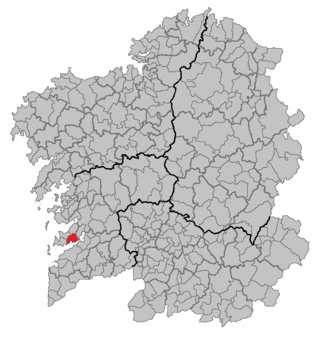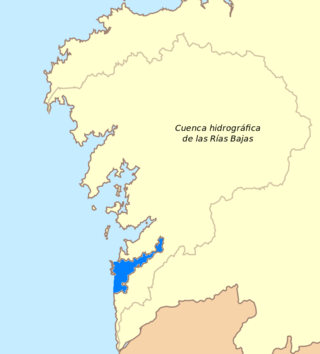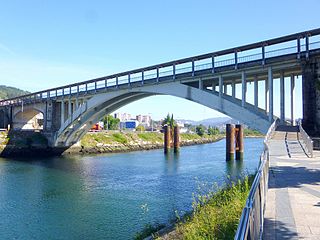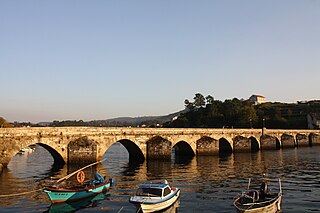
The Tamar Bridge is a suspension bridge over the River Tamar between Saltash, Cornwall and Plymouth, Devon in southwest England. It is 335 metres (1,099 ft) long, running adjacent the Royal Albert Bridge, and part of the A38, a main road between the two counties.

A cable-stayed bridge has one or more towers, from which cables support the bridge deck. A distinctive feature are the cables or stays, which run directly from the tower to the deck, normally forming a fan-like pattern or a series of parallel lines. This is in contrast to the modern suspension bridge, where the cables supporting the deck are suspended vertically from the main cable, anchored at both ends of the bridge and running between the towers. The cable-stayed bridge is optimal for spans longer than cantilever bridges and shorter than suspension bridges. This is the range within which cantilever bridges would rapidly grow heavier, and suspension bridge cabling would be more costly.

The Rio–Niterói Bridge, officially the President Costa e Silva Bridge, is a box girder bridge spanning the Guanabara Bay, connecting the cities of Rio de Janeiro and Niterói in the State of Rio de Janeiro, Brazil. It is currently the second longest bridge in Latin America, after the Metro Line 1 bridge, and the 48th longest in the world in 2020. From its completion in 1974 until 1985 it was the world's second-longest bridge, second only to the Lake Pontchartrain Causeway.

The Millau Viaduct is a multispan cable-stayed bridge completed in 2004 across the gorge valley of the Tarn near Millau in the Aveyron department in the Occitanie Region, in Southern France. The design team was led by engineer Michel Virlogeux and English architect Norman Foster. As of September 2020, it is the tallest bridge in the world, having a structural height of 336.4 metres (1,104 ft).

The General Rafael Urdaneta Bridge is located at the Tablazo Strait outlet of Lake Maracaibo, in western Venezuela. The bridge connects Maracaibo with much of the rest of the country. It is named after General Rafael Urdaneta, a Venezuelan hero of Independence who was born in Maracaibo.

The 25 de Abril Bridge is a suspension bridge connecting the city of Lisbon, capital of Portugal, to the municipality of Almada on the left (south) bank of the Tagus River. It has a total length of 2,277 metres (7,470 ft), making it the 46th longest suspension bridge in the world.

The Strait of Gibraltar crossing is a hypothetical bridge or tunnel spanning the Strait of Gibraltar that would connect Europe and Africa. The governments of Spain and Morocco appointed a joint committee to investigate the feasibility of linking the two continents in 1979, which resulted in the much broader Euromed Transport project.

Moaña is a municipality of 18,709 inhabitants located in Galicia, Spain in the province of Pontevedra. It is one of the five municipalities with Bueu, Cangas do Morrazo, Marin and Vilaboa that forms the peninsula of O Morrazo. This peninsula separates the Ria of Vigo from the Ria of Pontevedra. The coast of Moaña has several beaches and the area combines tourism with traditional seafood production. The surrounding sea contains sea farms where mussels, oysters and other species are cultivated and it is an idyllic place for practicing sea sports activities. The Strait of Rande, where the Rande Bridge now connects Moaña with the municipality of Redondela, was the scene of the Battle of Vigo Bay. Moaña has developed a significant cultural life with the highlights of this being the Interceltic Festival of Morrazo, the Week of Carnival and numerous other local feasts. Social movements were relevant in Moaña in the first half of the 20th century where the presence of the CNT was significant. In fact, the current local pub/bar for retired people was the head office of this syndicate in Moaña during the Second Spanish Republic.

The Bandra-Worli Sea Link is a 5.6 km long, 8-lane wide bridge that links Bandra in the Western Suburbs of Mumbai with Worli in Central Mumbai. It is the longest sea bridge, as well as the 4th longest bridge in India after Bhupen Hazarika Setu, Dibang River Bridge and Mahatma Gandhi Setu. It is a cable-stayed bridge with pre-stressed concrete-steel viaducts on either side. It was planned as a part of the proposed Western Freeway that would link the Western Suburbs to Nariman Point in Mumbai's main business district, but is now planned to become part of the Coastal Road to Kandivali.

The AP-9 or Autoestrada do Atlántico is a toll motorway in Galicia, Spain. It starts in A Coruña and runs south past the cities of Santiago de Compostela, Pontevedra and Vigo, before ending at the town of Tui, a few kilometres north of the Portuguese border at the Minho River.

Riccardo Morandi was an Italian civil engineer best known for his innovative use of reinforced concrete and prestressed concrete, although over the years some of his particular cable-stayed bridges have had some maintenance trouble.

The Trezzo sull'Adda Bridge or Trezzo Bridge was a medieval bridge at Trezzo sull'Adda in Lombardy, Italy, spanning the Adda river. Completed in 1377, the single-arch bridge held the record for the largest span for over four hundred years, until the beginnings of the Industrial Age, while it was not until the early 20th century that masonry bridges with larger openings were constructed.

Fabrizio de Miranda was an Italian bridges and structural engineer and university professor.

Indiano Bridge is the first earth-anchored cable-stayed bridge in the world. It is a bridge across the Arno River in Florence (Italy) (near the Indian Monument of Rajaram II .

Vigo Ria and is an estuary in Galicia, Spain. It is the southernmost ria of the Rías Baixas. It is located south of the province of Pontevedra, and extends in a northeast direction over a distance of 35 kilometres (22 mi) from its mouth at Cape Silleiro to the deepest point in Arcade, with a maximum width of 7 kilometres (4.3 mi) and is narrowest in the Strait of Rande, at 700 metres (2,300 ft). Its western entrance is protected by the Cies Islands, which are part of the National Park of the Atlantic Islands, within the islands of Toralla and San Simon. Its borders the north with Morrazo Peninsula. In the extreme south lies the Bay of Baiona. Its easy access, deep draft and calm waters make the Vigo estuary an ideal retreat for sailing and water sports.

Ponte Morandi, officially Viadotto Polcevera, was a road viaduct in Genoa, Liguria, Italy, constructed between 1963 and 1967 along the A10 motorway over the Polcevera River, from which it derived its official name. It connected Genoa's Sampierdarena and Cornigliano districts across the Polcevera Valley. The bridge was widely called "Ponte Morandi" after its structural designer, engineer Riccardo Morandi.

The Burgo Bridge(Puente del Burgo) is a medieval bridge, built over an older bridge of Roman origin, which crosses the Lérez River in the city of Pontevedra, Spain. It is on the route of the Portuguese Way to the north of the historic centre of Pontevedra and to the south of the Burgo neighbourhood. Between the arches above the pillars are carved the famous stone pilgrim's shells.

The Barca Bridge is a bridge over the Lérez River, at its mouth in the Pontevedra Ria, which connects the city of Pontevedra with the municipality of Poio in Spain.

The Santiago Bridge crosses the Lérez River in the city of Pontevedra (Spain), where the N-550 road runs alongside it. It connects the city centre with the A Xunqueira area and the O Burgo district.

The Puente Sampayo Bridge is a medieval bridge that crosses the Verdugo River between the civil parish of Ponte Sampaio in the municipality of Pontevedra and the civil parish of Arcade in the municipality of Soutomaior in Spain.





















